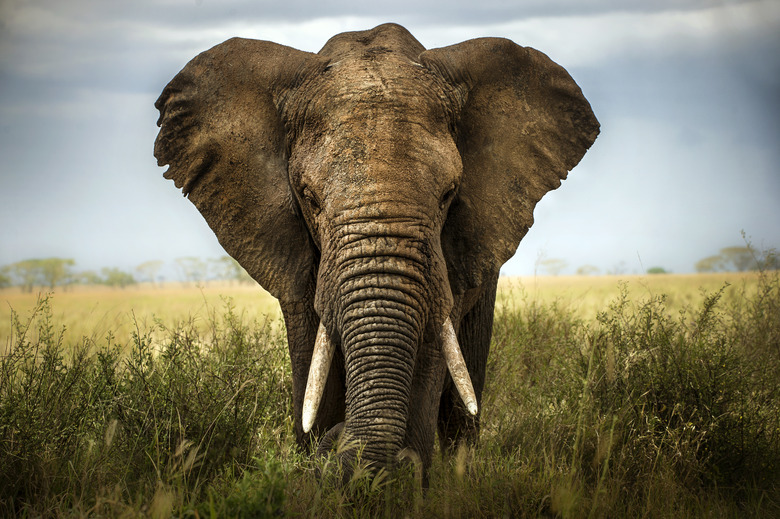The Differences Between Mammoths & Elephants
Mammoths and elephants are two groups of long-trunked, big-tusked and typically enormous herbivores that both enjoy a long and storied relationship with human beings. Aside from the obvious fact that mammoths are extinct, a number of physical, ecological and geographic differences distinguish these behemoths. Some people erroneously assume that elephants descended from mammoths, but they're actually close cousins that share a common ancestor. The last, relict population of woolly mammoths on Arctic Russia's Wrangel Island exited the earthly stage some 4,000 years ago, while elephants still lumber across Asia and Africa.
Taxonomic Relationship
Taxonomic Relationship
Mammoths and elephants are close cousins belonging to the same taxonomic family, the Elephantidae. Elephantids, as they're called, also belong to the broader biological group Proboscidea: an order of otherwise extinct beasts, such as mastodons and deinotheres.
Elephants and mammoths diverged between five and three million years ago to form three genera in the family: Loxodonta, the African elephants; Elephas, the Asian elephant; and Mammuthus, which includes the several vanished species of mammoths. Research has swung back and forth on the issue of which modern elephant is more closely related to mammoths, although much evidence suggests it is the Asian lineage.
Mammoth vs. Elephant Geography
Mammoth vs. Elephant Geography
As a genus, mammoths ranged further across the globe than their elephant relatives. While the latter have always been restricted to Africa and Eurasia, mammoths penetrated the New World via the Bering land bridge linking modern-day Siberia and Alaska during Pleistocene glacial periods, as early as 1.7 million years ago.
More than one mammoth line occupied North America: The Columbian, or imperial, mammoth, perhaps the biggest of all, represented an earlier colonization than the woolly mammoth, which arrived from Eurasia later on in the Pleistocene.
Big and Small
Big and Small
Mammoths and modern elephants overlap significantly in body mass. The biggest African bush elephants may stand roughly as tall as did the titanic Columbian mammoth of North America, some 13 feet at the shoulder, but the largest mammoths probably generally outweighed elephants because of thicker leg bones, but there are prehistoric examples of "insular dwarfism" in both elephants and mammoths. Insular dwarfism includes cases of island-bound populations of the elephantids became progressively smaller across generations because of limited space and resources. The Channel Islands mammoth, for example, evolved on its namesake islands off California from ancestral Columbian mammoths, but stood only some 5-feet, 10-inches tall and may have weighed only 441 to 1,102 pounds.
Tusks and Teeth
Tusks and Teeth
Perhaps the most pronounced physical difference between mammoths and elephants is their tusks. Mammoth tusks were typically longer in proportion to body size and more dramatically twisted and curved than elephant tusks. Columbian mammoths wielded tusks as long as 16 feet, while the record-length tusk for the African elephant, which grows bigger ones than its Asian cousin, was 11-feet, 7-inches long. In mammoths and African elephants, both sexes carry tusks. Among Asian elephants, only the bulls typically grow them. The massive, flat-topped molars of mammoths, apparently adapted for a grass-dominated diet, resemble those of Asian elephants: studded teeth with parallel enamel ridges. In comparison, the African elephant has fewer and diamond-shaped tooth ridges.
Elephantid Profiles
Elephantid Profiles
Mammoths had a humped profile because of disproportionately long forelimbs and high shoulder vertebrae. The backs of Asian elephants generally appear more rounded, while the high-shouldered African elephant has a "dished" outline — partly because of rear limbs proportionately longer than in its Asian cousins or mammoths. The forehead of the Asian elephant is pronounced and that of mammoths even more so, while the brow of the African elephant has a gentler slope.
Other Physical Differences
Other Physical Differences
The ears of African elephants are much larger than those of Asian elephants and of mammoths. The exceptionally small ears of woolly mammoths better protected them from cold temperatures. That tundra species certainly was hairier than elephants are — it had both an undercoat and an outer one — but mammoth varieties from more temperate latitudes likely had mostly bare hides. Trunk tips differ among the elephantids, too. African elephants and mammoths have two fingerlike extensions at the tip — though of different shapes — while the Asian elephant has just one.
References
- Mammoths: Ice-Age Giants; Larry D. Agenbroad, Lisa W. Nelson
- Biology: The Dynamic Science; Peter Russell, et al.
- The Fate of the Mammoth: Fossils, Myth, and History; Claudine Cohen
- Mammoths, Mastodonts, and Elephants: Biology, Behavior, and the Fossil Record; Gary Haynes
- University of California Museum of Paleontology: About Mammoths
- Horns, Tusks, and Flippers: The Evolution of Hoofed Mammals; Donald R. Prothero, Robert M. Schoch
- National Park Service: Channel Islands National Park — The Pygmy Mammoth
- San Diego Zoo: Elephant & Mastodon Comparisons
- Children's Discovery Museum of San Jose: How Big Do Tusks Get?
Cite This Article
MLA
Shaw, Ethan. "The Differences Between Mammoths & Elephants" sciencing.com, https://www.sciencing.com/differences-between-mammoths-elephants-8702804/. 5 April 2018.
APA
Shaw, Ethan. (2018, April 5). The Differences Between Mammoths & Elephants. sciencing.com. Retrieved from https://www.sciencing.com/differences-between-mammoths-elephants-8702804/
Chicago
Shaw, Ethan. The Differences Between Mammoths & Elephants last modified March 24, 2022. https://www.sciencing.com/differences-between-mammoths-elephants-8702804/
